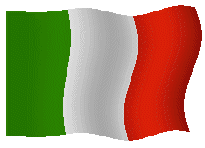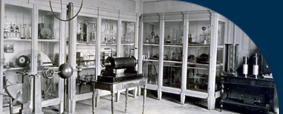 |
Device demonstrating the continuous rotation of a moving circuit by means of a fixed circular current |
 |
Apparato per mostrare la rotazione continua di un circuito mobile per mezzo di una corrente circolare |
| Subject: electrodynamics/ Ampère's law |
Settore: elettrodinamica/legge di Ampère |
| Number of catalogue: 344 |
Numero di inventario: 344 |
| On the mahogany base: "Secretan a Paris" [carved] |
Sulla base in mogano: "Secretan a Paris" [inciso] |
| 1868 [document] |
Periodo di costruzione: 1868 [documento] |
| Mahogany, copper, brass, boxwood |
Materiali utilizzati: Mogano, rame, ottone, legno di bosso |
| 320 X 400 X 190 [mm] |
Dimensioni: 320 X 400 X 190 [mm] |
| |
|
This device demonstrates the electrodynamic interaction of two electric circuits, one fixed and the other mobile. The fixed circuit, placed on a horizontal plane, is a circular current which is able to set up the continuous rotation of a mobile circuit through which horizontal and vertical segments of curren run. |
Questo apparato mostra l'interazione elettrodinamica di due circuiti elettrici, il primo fisso e il secondo mobile. Il circuito fisso, posto in un piano orizzontale, è una corrente circolare che è in grado di imprimere un moto rotatorio continuo ad un circuito mobile percorso da tratti di corrente orizzontale e verticale. |
| |
|
Description: A copper vase attached to a mahogany support, contains acidulated water and has a broad edge. A wooden circular frame fixed under it surrounds the copper container and a coil of copper wire, insulated with green silk, is wrapped around it. The centre of the vase is inserted on a boxwood base which is integral to a vertical brass column (therefore insulated from the vase) which has in its upper part a small brass capsule into which mercury is poured. The mobile circuit consists of a frame having two horizontal and vertical arms of copper wire that is supported in the middle horizontal part and is able to rotate freely from a metal point based on the bottom of the small brass capsule. The vertical sides of the frame are welded in the lower part to a light copper ring immersed in the acidulated water contained in the vase. The supply of the mobile and fixed circuits is made through four brass rheofores placed on the base of the device: the external rheofores supply the coil, whereas the internal ones, connected with the brass column and with the copper vase, respectively, supply the mobile circuit. |
Descrizione: Su un basamento in mogano è alloggiato un vaso in rame contenente dell'acqua acidulata ed avente un ampio bordo. Sotto di esso è fissato un telaio circolare di mogano (che circonda quindi il recipiente di rame) su cui è avvolto una bobina di filo di rame ben isolata da seta verde. Il vaso è centralmente fissato ad incastro su uno zoccolo di legno di bosso, solidale ad una colonna verticale d'ottone (quindi isolata dal vaso) che porta superiormente una capsulina d'ottone in cui si mette del mercurio. Il circuito mobile consiste in un telaio avente due rami orizzontali e verticali di filo di rame che nella sua parte mediana orizzontale è sostenuto, e in grado di ruotare liberamente, da una punta metallica che si appoggia sul fondo della capsulina d'ottone. Il telaio ha i suoi lati verticali saldati inferiormente ad un leggero anello di rame immerso nell'acqua acidulata contenuta nel vaso. L'alimentazione dei circuiti mobile e fisso avviene mediante quattro serrafili d'ottone posti sul basamento dell'apparecchio: quelli esterni alimentano la bobina, quelli interni, essendo collegati rispettivamente alla colonna d'ottone e al vaso di rame, alimentano il circuito mobile. |
| |
|
Function: By shortcircuiting the rheofores that are linked to one extremity of the fixed coil and to the brass column, respectively, an electric circuit is achieved which, if properly supplied with a battery linked (having the correct polarities) to the two remaining poles, causes the mobile circuit to turn in a direction opposite to that of the fixed current as the coil. Vice versa, to make the mobile circuit turn in the same direction of the fixed circular current, it is sufficient to produce an inversion of current only in the mobile circuit and not in the fixed one. In order to do this, it is necessary to shortcircuit the rheofores that are connected with one extremity of the fixed coil and with the copper vase, respectively. |
Funzionamento: cortocircuitando i serrafili, collegati rispettivamente ad un estremo della bobina fissa e alla colonna d'ottone, si ottiene un circuito elettrico che, se opportunamente alimentato da una batteria connessa (con le giuste polarità) ai restanti due serrafili, fa ruotare il circuito mobile in una direzione opposta a quella della corrente fissa della bobina. Viceversa, per far girare il circuito mobile nello stesso senso della corrente circolare fissa, basta produrre l'inversione della corrente nel solo circuito mobile e non in quello fisso. A tale scopo è sufficiente cortocircuitare i serrafili connessi rispettivamente ad un estremo della bobina fissa ed al vaso di rame. |
| |
|
Bibliography: Ganot [1855], pp. 650-651; Deschanel [1873], pp. 683-684; Marco [1883], vol. II, pp. 208-210.
|
Bibliografia: Ganot [1855], pp. 650-651; Deschanel [1873], pp. 683-684; Marco [1883], vol. II, pp. 208-210. |

